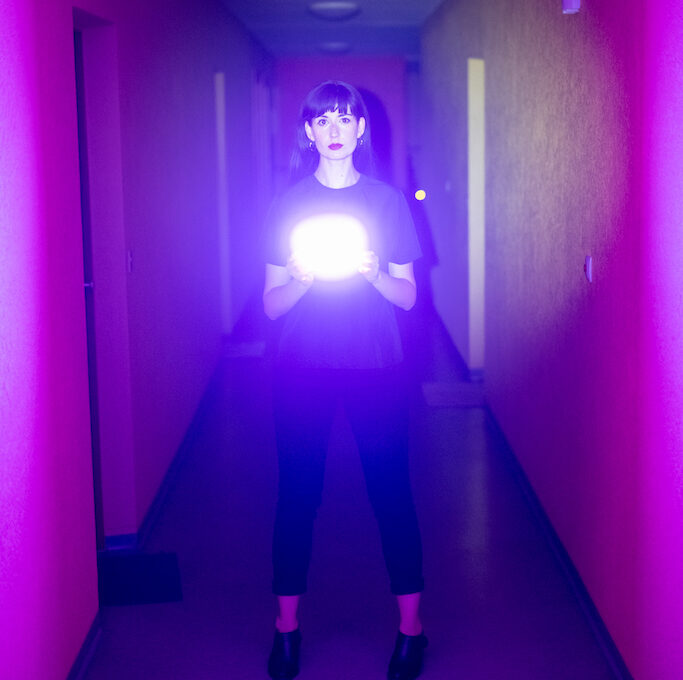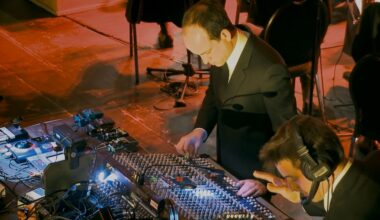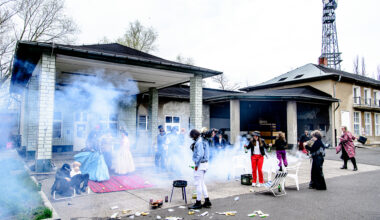Berlin composer Maya Shenfeld’s music is as powerfully evocative as it is strikingly intimate. Through a mastery of sound sculpting and visionary approach to composition Shenfeld has established herself as one of the most vital voices in Berlin’s New Music scene. Her work exists in liminal spaces, collapsing the boundaries between electronic synthesis and organic sound as it draws equally from classical tradition and underground experimentalism. Each aspect of her output, from site-specific sound installations to works for new music ensembles and even playing guitar in punk bands, combines an astute technical prowess with an authentic, tangible expression of soul. Shenfeld’s debut solo record In Free Fall merges the grand vision of orchestral music with the granularity and intimacy of deep listening, exploring a tension between immaculately structured compositional architecture and the sheer joy of noise, grain and feedback.
FACTS
1. Rose is a rose is a rose is a rose
2. ΔS ≥ 0
3. Being in free fall may lead to spatial disorientation, a sense of confusion between the self and its surroundings to such an extent that this distinction itself may dissolve.
QUESTIONS
1. What is the biggest inspiration for your music?
One of the first things that come to mind is meditation, both the experiences I’ve had while meditating, but also this highly focused, present, and embodied state of mind we tap into while listening to music, or playing music. There are other things too: interior and exterior landscapes, colour palettes, conversations with friends, or just a certain mood.
2. How and when did you get into making music?
This might sound like a bit of a cliché, but ever since I can remember myself I always gravitated towards music. From a very young age, I attended a music-focused school that offered an old-world, rigorous, conservative, music education. My main instrument was classical guitar, and as I grew older I had a somewhat complicated relationship with my classical upbringing: the fluorescent-lit concert halls, the traditional role ascribed to the performer, the hierarchy (and patriarchy) of it all. Music is what brought me to Berlin over a decade ago, though my practice had its share of twists and turns, I shifted towards improvisation and composition and, at the same time, joined a punk band. For a while I found myself playing at venues such as the Konzerhaus Berlin, or the opera, just to join my band the next day at some of the city’s most infamous indie venues (a far cry from ’s Techno temples). I never stopped loving classical music though, and through these experiences I started engaging with it differently, bringing to it this sort of more immediate, unrestrained connection.
3. What are 5 of your favourite albums of all time?
Yo La Tengo – And Then Nothing Turned Itself Inside Out
Morton Feldman – Palais de Mari
Laurie Anderson – Heart of a dog
Alice Coltrane – Journey in Satchinanda
Johannes Brahms – Cello Sonatas (Pieter Wisplewey)
4. What do you associate with Berlin?
Its dense, strange, combination of dark history and contemporary euphoria, open wounds, and current-day exchanges, dialogues, dances, which I think could never take place anywhere else.
5. What’s your favourite place in your town?
The “Rote Insel” – where I live, a sliver of Schöneberg known in German as the ‘Red Island’ for its location between two train tracks and its historical association with antifascist working-class politics. I moved here a couple of years ago, and living on the Island still feels somehow like being on vacation. I don’t know why exactly. Maybe it’s that it’s surrounded by parks, or that it’s ever so slightly elevated from Berlin’s flatlands. Something about it feels like it’s out of time, and out of place.
6. If there was no music in the world, what would you do instead?
Dance
7. What was the last record/music you bought?
Midori Hirano, Invisible Island
8. Who would you most like to collaborate with?
Jim Jarmusch. I love SQÜRL. I love his films and their sound –– so that’d be pretty amazing. Another dream collaboration would be with choreographer Sharon Eyal, definitely a fan of her work.
9. What was your best gig (as performer or spectator)?
About two years ago I led an ensemble of sixteen women playing guitar and bass for the performance of Julius Eastman’s Gay Guerrilla. We performed at the opening event of Schinkel Pavillion’s performance series Disappearing Berlin. It was sunset and later a bright night’s sky at the top vacant floor of the Postbank Hochaus, one of the few and iconic skyscrapers in Kreuzberg. I still get goosebumps thinking back to these performances, being together, the ensemble and our audience, making music together in this way (all the more so looking back after this long lockdown winter) –– it was electric.
10. How important is technology to your creative process?
It’s sort of a means to an end, isn’t it?
For me, a new composition begins by building sonic, harmonic, and contrapuntal castles in the air. It then slowly materialises in the form of written sketches, phone recordings, riffs on the keyboard, or the guitar. The exciting thing about technology might be its relative accessibility –– the sketches can turn into an orchestrated piece or a fully produced recording, right here, in my bedroom. Though it can also be confusing, misleading or just overwhelming. More often than not, stepping away from the computer, or any other screen, is what’s best for me. That’s all just to say, if technology didn’t exist, whether it’s an analogue synth, or a quantum computer (or even just a pencil…), I hope I’d keep on building imaginary sonic castles in the air.
11. Do you have siblings and how do they feel about your career/art?
Two siblings, despite each of us living on a different continent, they’re as supportive as can be. My sister’s creative practice as a fashion designer has been a huge inspiration throughout the making of In Free Fall. In fact, she designed the artwork for the record’s cover, collaborating on this was one of the most exciting aspects of preparing for the release.
Photo © Maya Shenfeld


